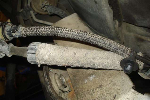Rogers-Explorer
Member
- Joined
- April 1, 2007
- Messages
- 37
- Reaction score
- 0
- City, State
- Halifax, Nova Scotia (Posted to Edmonton, AB for now)
- Year, Model & Trim Level
- 1997 Explorer XLT
TPS 1997 Explorer
I have a 97 XLT 4.0L OHV. After struggling with the ridiculous screws holding the TPS on, I had a look at the wiring - no green wire. I have three wires - black/gray, black/red, gray.
I checked the voltage to each - -0.02V, -0.02V, -4,97V.
Am I missing something?
Cheers, Roger
I have a 97 XLT 4.0L OHV. After struggling with the ridiculous screws holding the TPS on, I had a look at the wiring - no green wire. I have three wires - black/gray, black/red, gray.
I checked the voltage to each - -0.02V, -0.02V, -4,97V.
Am I missing something?
Cheers, Roger

 Drove the vehicle after the TPS adjustment and it has made a difference. It used to stumble at light throttle and would jerk when driving through town at 25 MPH. It now runs a lot smoother.
Drove the vehicle after the TPS adjustment and it has made a difference. It used to stumble at light throttle and would jerk when driving through town at 25 MPH. It now runs a lot smoother.












